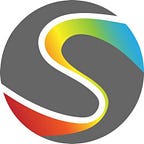What’s Next After Flat Design?
If you don’t recognise the term flat design, you’re almost certainly familiar with it in all but name. It denotes the simplistic, classical design that has become all but ubiquitous in modern UI design — a clean aesthetic that favours a minimalistic style by flattening icons and art imbuing them with bold, solid colours. The design is intended to cut out clutter and distraction while allowing users to perceive and comprehend icons more quickly. Windows 8 tiles were one of the first prominent examples of this, and the style was quickly popularised by Apple and Google.
An example of flat design
Flat design largely replaced skeuomorphic design, a form which retained design cues that were required in previous iterations but are no longer necessary, appearing like its real life counterpart. As an example, think of the page binding rings that would appear in a calendar icon. Skeuomorphic design was used to make iconography more lifelike and recognisable to the viewer, bridging a gap between the physical and digital world. Of course, with technology becoming increasingly integral to our lives, that bridge became unnecessary and was gradually replaced by flat design. Instagram’s transition from a shadowed, lifelike icon of a polaroid camera to its current iteration, a brightly coloured, simplistic icon, is a good example of this.
Instagram opted to update their skeuomorphic logo to a flat design
However, flat design has been around for quite some time meaning a change or evolution is likely on the horizon. Google recently unveiled Material Design, which looks to be reintroducing some of the shadow and depth used in skeuomorphic design, citing realistic lighting, while retaining the bright, bold colours and clean edges of flat design. Isometric icons, which are 2D but give the illusion of depth, are also making a comeback. The Rio Olympics 2016 logo featured yellow, blue and green interlocking loops which appear to be three figures dancing in a circle.
Hero images are also becoming increasingly popular in website design. These are full screen, high quality photos, usually with large text superimposed over the image. While retaining a clean, simplistic style the website can communicate something extra about the brand’s identity. This kind of website means that information isn’t top loaded — instead users scroll down for more information, often accompanied by more glossy imagery. As mobile users are accustomed to ‘the long scroll’, this feels like an experience rather than a slog.
Cleverbird Creative using a Hero Image
Also, with the mass market launch of VR headsets this year, some have suggested this to be a possible future, probably envisaging Minority Report in the process. While VR is an exciting leap in technology, it’s still in its infancy and will first need years of refinement. Likewise, after the explosive but short lived popularity of Pokemon Go, AR or Augmented Reality has potential. While Google Glass was ultimately a flop, the popularity of Snapchat’s Spectacles may be the reinvention that this technology needs in order to gain traction. Plus, Apple is rumoured to be developing a Google Glass style wearable, so this technology may indeed have a bright future.
Another suggestion of the future of UI proposes that the next step is not the refinement of UI experience but instead the continuous reduction of UI. With products becoming more intuitive they can contextually appropriate choices for the consumer, deciding for you what’s relevant and presenting it in a condensed form (think wearable watches). By pursuing ‘calm technology’, or the reduction of intrusions by user interface, perhaps the future of UI is the device itself making much of the choices for you without your intervention.
Flat design, evidently, isn’t going away anytime soon given its popularity. However, it looks likely to evolve, incorporating remnants of old UI styles. Plus, with new and dynamic ways to interact with our technology, it will be interesting to see how flat design will adapt.
Scriba is a revolutionary, award-winning stylus that is designed to fit your hand. Find your creative flow with unique Squeeze-Motion technology: Scriba controls line weight and app functionality by bending in response to your touch — just squeeze. Available now on Amazon. Find out more at getscriba.com.
